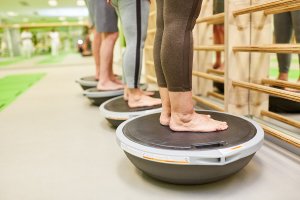Working Out Again After an Injury

Working out again after an injury isn’t an easy task. Even the most professionally trained athletes have to face the consequences of getting back in the game after periods of rest.
In any sport, there’s always a risk of injury; it’s just a fact that we can’t deny. Even if you take all the precautions possible to avoid and prevent problems, sometimes they just happen.
An injury gives rise to a new situation. You had a problem, you went through the treatment recommended by a professional, and you rested. After that, you probably asked yourself if you could return to working out after the injury you suffered.
Except for extreme conditions with serious effects, it’s possible to return to training normally after an injury. However, you must apply progression, patience, and supervision by a professional to help with healing. And if you’re conscious of what you’re doing, you’re preventing a repeat of that same injury.
It’s also important to analyze the injury you suffered so you understand how you got it. Maybe you didn’t warm up correctly, for example, or you overworked a muscle that was weak. Maybe you made an awkward movement that hurt a joint. If you can identify where things went wrong, you’ll recover more quickly.
Professional attention after an injury
It’s important if you want to return to working out after an injury, that you consult with a professional in sports medicine. A physiotherapist or a doctor will have the scientific knowledge necessary to help in your recovery.
The first point, really, is to receive a correct diagnosis. If an injury isn’t diagnosed properly, the recovery process can be downright torturous, let alone unhelpful. It’s not the same to recover from a sprain as it is from a torn muscle, just as muscle fatigue isn’t the same as a cramp.
Once the doctor diagnoses the injury, they’ll give the initial recommendations. There will be recommendations for rest, and the application of temperature – cold or hot depending on the case – the use of anti-inflammatory drugs, and follow-up visits to confirm the healing is taking place.

After this period of rest, you’ll probably feel scared to start training again. That’s why it’s absolutely necessary to consult with a professional. Your fears will dissipate with the help of a specialist who has tools to make sure you’re sure about your recovery plan.
Warm-ups
Warm-ups are vitally important for your body, but especially when you return to exercising after an injury. Not warming up might even be the reason you injured yourself in the first place.
It’s important to combine short aerobic exercises with stretches and warm-ups. Independently of the sport you practice, you’ll need to warm-up the central part of the body, as well as your brain. For this second one, you’ll work on some exercises that require dynamic concentration.
Regaining your strength after an injury
For your workouts when you return after an injury, you’ll need to strengthen your muscles again. After having rested, you’ll have lost some of your muscle mass and its tonicity.
Strengthening exercises are what you need for this task. You can’t start too roughly, but you do need to pay special attention to strengthening the muscles around the injured area. Each sport, in this case, has its own strengthening routines for the most essential parts of the body.
It’s also a good idea to identify your weak spots. It’s possible, for example, that you became injured because you didn’t develop some areas of the body well enough. This is the time, then, to do it right.
Developing the joints
Joint flexibility is also an important training component after an injury. The stability of joints give balance to the entire body and help prevent future injuries. Make sure you’re using correct posture and positioning, passively as well as actively.
That’s why proprioception training exists. Many athletes resist this because they consider it unnecessary or too extravagant. However, there’s a notable difference between those who practice it and those who don’t.

Proprioception training consists of maintaining static positions that require balance. The muscles and the joints are forced to correct your posture constantly. Your brain, for its part, sharpens your concentration to order the muscles into contractions and relaxation to avoid a fall.
Moving on after an injury
Finally, experts recommend progressing into your normal training routine gradually. No one can simply max out their capacity immediately; you need to go from little to more to prevent yourself from getting hurt.
You shouldn’t be scared to return to exercising after an injury, but it’s good to be cautious and take the necessary precautions when returning. Progress gradually, and you’ll guarantee that you can keep enjoying your favorite physical activity.
Working out again after an injury isn’t an easy task. Even the most professionally trained athletes have to face the consequences of getting back in the game after periods of rest.
In any sport, there’s always a risk of injury; it’s just a fact that we can’t deny. Even if you take all the precautions possible to avoid and prevent problems, sometimes they just happen.
An injury gives rise to a new situation. You had a problem, you went through the treatment recommended by a professional, and you rested. After that, you probably asked yourself if you could return to working out after the injury you suffered.
Except for extreme conditions with serious effects, it’s possible to return to training normally after an injury. However, you must apply progression, patience, and supervision by a professional to help with healing. And if you’re conscious of what you’re doing, you’re preventing a repeat of that same injury.
It’s also important to analyze the injury you suffered so you understand how you got it. Maybe you didn’t warm up correctly, for example, or you overworked a muscle that was weak. Maybe you made an awkward movement that hurt a joint. If you can identify where things went wrong, you’ll recover more quickly.
Professional attention after an injury
It’s important if you want to return to working out after an injury, that you consult with a professional in sports medicine. A physiotherapist or a doctor will have the scientific knowledge necessary to help in your recovery.
The first point, really, is to receive a correct diagnosis. If an injury isn’t diagnosed properly, the recovery process can be downright torturous, let alone unhelpful. It’s not the same to recover from a sprain as it is from a torn muscle, just as muscle fatigue isn’t the same as a cramp.
Once the doctor diagnoses the injury, they’ll give the initial recommendations. There will be recommendations for rest, and the application of temperature – cold or hot depending on the case – the use of anti-inflammatory drugs, and follow-up visits to confirm the healing is taking place.

After this period of rest, you’ll probably feel scared to start training again. That’s why it’s absolutely necessary to consult with a professional. Your fears will dissipate with the help of a specialist who has tools to make sure you’re sure about your recovery plan.
Warm-ups
Warm-ups are vitally important for your body, but especially when you return to exercising after an injury. Not warming up might even be the reason you injured yourself in the first place.
It’s important to combine short aerobic exercises with stretches and warm-ups. Independently of the sport you practice, you’ll need to warm-up the central part of the body, as well as your brain. For this second one, you’ll work on some exercises that require dynamic concentration.
Regaining your strength after an injury
For your workouts when you return after an injury, you’ll need to strengthen your muscles again. After having rested, you’ll have lost some of your muscle mass and its tonicity.
Strengthening exercises are what you need for this task. You can’t start too roughly, but you do need to pay special attention to strengthening the muscles around the injured area. Each sport, in this case, has its own strengthening routines for the most essential parts of the body.
It’s also a good idea to identify your weak spots. It’s possible, for example, that you became injured because you didn’t develop some areas of the body well enough. This is the time, then, to do it right.
Developing the joints
Joint flexibility is also an important training component after an injury. The stability of joints give balance to the entire body and help prevent future injuries. Make sure you’re using correct posture and positioning, passively as well as actively.
That’s why proprioception training exists. Many athletes resist this because they consider it unnecessary or too extravagant. However, there’s a notable difference between those who practice it and those who don’t.

Proprioception training consists of maintaining static positions that require balance. The muscles and the joints are forced to correct your posture constantly. Your brain, for its part, sharpens your concentration to order the muscles into contractions and relaxation to avoid a fall.
Moving on after an injury
Finally, experts recommend progressing into your normal training routine gradually. No one can simply max out their capacity immediately; you need to go from little to more to prevent yourself from getting hurt.
You shouldn’t be scared to return to exercising after an injury, but it’s good to be cautious and take the necessary precautions when returning. Progress gradually, and you’ll guarantee that you can keep enjoying your favorite physical activity.
All cited sources were thoroughly reviewed by our team to ensure their quality, reliability, currency, and validity. The bibliography of this article was considered reliable and of academic or scientific accuracy.
- Bahr, Roald, and Sverre Maehlum. Lesiones Deportivas/Sports Injuries: Diagnóstico, Tratamiento Y Rehabilitación/Diagnostic, Treatment and Rehabilitation. Ed. Médica Panamericana, 2007.
- Hüter-Becker, Antje. La rehabilitación en el deporte. Vol. 44. Editorial Paidotribo, 2005.
- Gusi Fuertes, Narcis, and Luis Pablo Rodríguez Rodríguez. Manual de prevención y rehabilitación de lesiones deportivas. Síntesis, 2002.
This text is provided for informational purposes only and does not replace consultation with a professional. If in doubt, consult your specialist.








